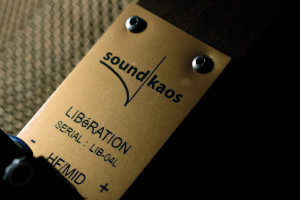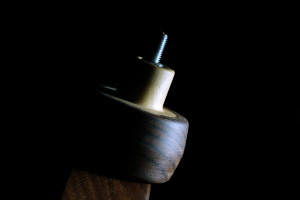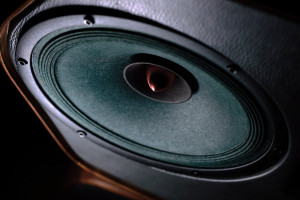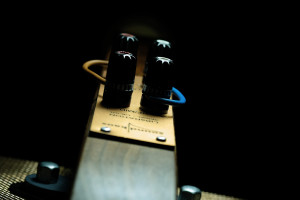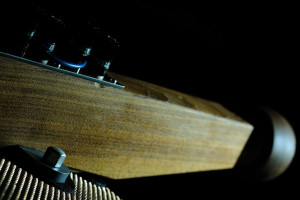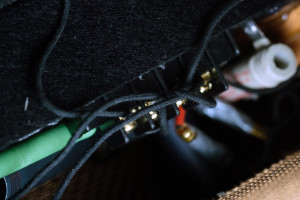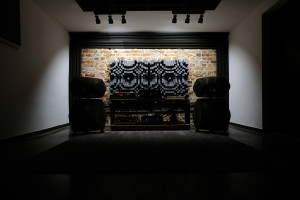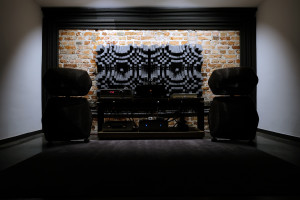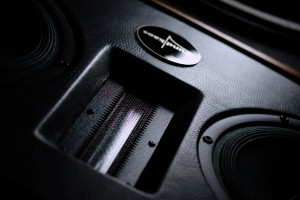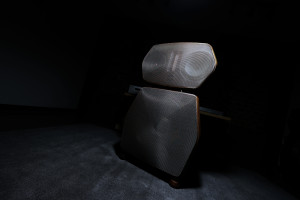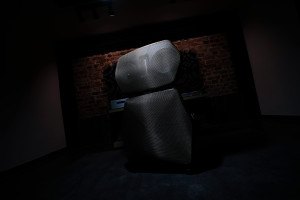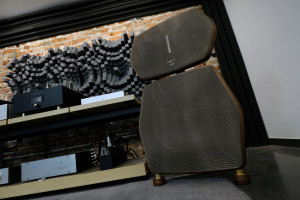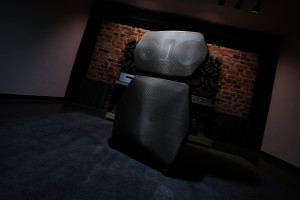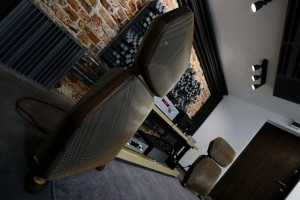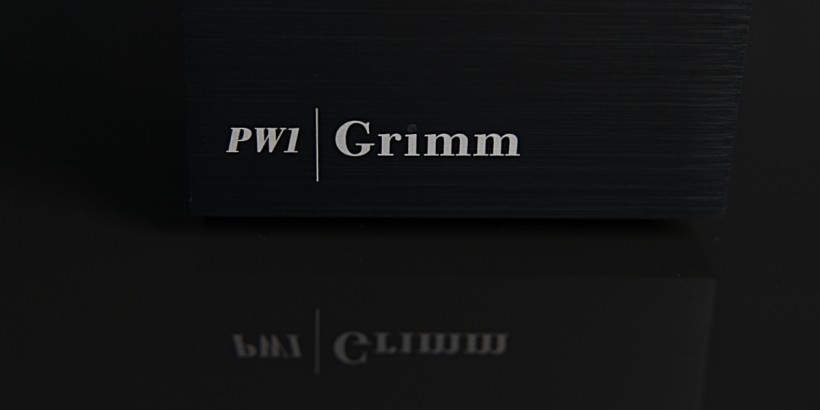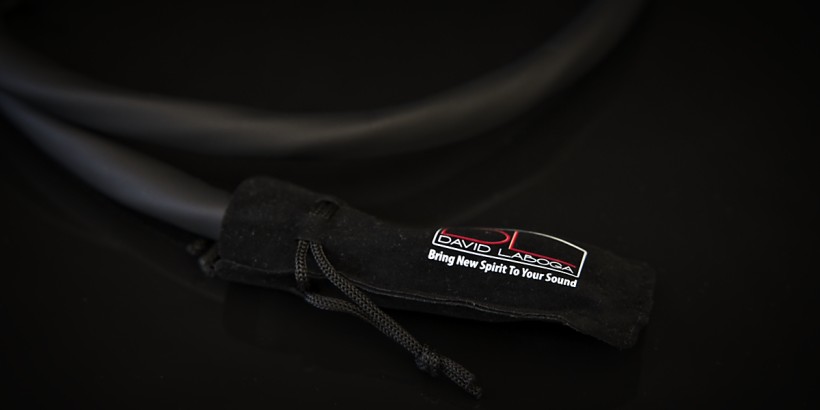Martin Gateley’s soundkaos brand stirred the market well and on several occasions I had the pleasure to witness why. The man’s goods have been on my radar for quite a while and – shortly past the recent local Audio Video Show – two of his boxes were sent my way. Logistics couldn’t have been any easier for the two of us this time around and that’s how soundkaos Libération became this review’s main dish. Enjoy!
Introduction
The noun ‘chaos’ means a state of disorder, confusion and most likely not something desirable to begin with, especially in our hobby. Short investigation on this report’s company – soundkaos – implies that its owner Martin Gateley has to have either a great sense of humour or positively twisted mind then. Or perhaps both, simply because nothing about his audio related work is chaotic, on the contrary in fact. At least that’s what yours truly chose to believe past several convos he had with the Swiss himself, whereas a number of auditions and visual inspections of his products contributed to the effect as well.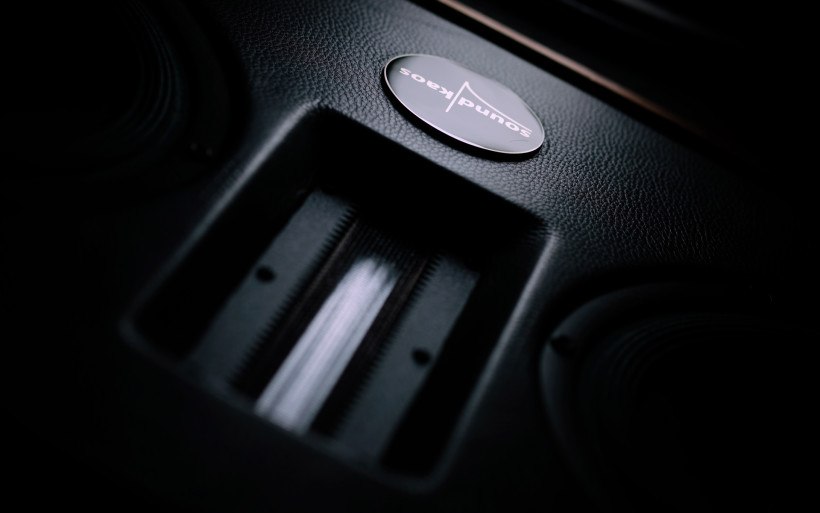 Martin Gateley established his audio business as a hobby activity more than a decade ago, but the word ‘kaos’ he’s been exploiting for twice as long. His main operation – kaosevents – is into full implementation of worldwide trade show exhibits; from rough concept to design, assembly and then final setup, all accordingly to a client’s needs. And there were several high-profile ones; BMW/Sauber and Renault Formula One racing teams, Böhringer Ingelheim, Accenture and O2 to name just few listed on-site. This work requires creativity, resourcefulness, top tier managing skills to handle all subcontractors involved and being utmost organized to meet presumably one deadline after another. Perhaps Martin thrives on this kaos? And sleeps soundly only when it’s under control?
Martin Gateley established his audio business as a hobby activity more than a decade ago, but the word ‘kaos’ he’s been exploiting for twice as long. His main operation – kaosevents – is into full implementation of worldwide trade show exhibits; from rough concept to design, assembly and then final setup, all accordingly to a client’s needs. And there were several high-profile ones; BMW/Sauber and Renault Formula One racing teams, Böhringer Ingelheim, Accenture and O2 to name just few listed on-site. This work requires creativity, resourcefulness, top tier managing skills to handle all subcontractors involved and being utmost organized to meet presumably one deadline after another. Perhaps Martin thrives on this kaos? And sleeps soundly only when it’s under control?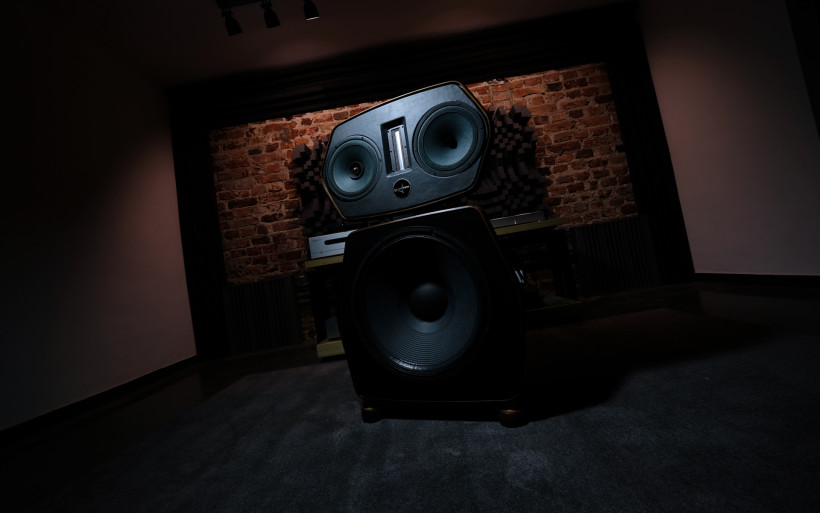 Martin interviewed by Srajan here revealed that the decision to make his own loudspeakers happened because of three things; early contact with such items, lots of great music his father introduced him to and the creation process itself. Exhibition areas or speakers made under one brand or the other highly likely don’t really matter to our man as the creative pattern in both cases is quite similar, a rough concept forged into something very real. Yours truly met Martin in person in Munich in 2016. His Libération model backed by SOtM hardware was showcased for the first time in a small room and sounded promising to say the least, but for the next opportunity to listen to it I had to wait until the same event in 2017. Martin and his wife exhibited along with Nagra and Vovox in gorgeously domestic and peaceful wooden room, which netted quite the interest among visitors. This homely shack looked very labour intense, I do wondered who designed and assembled it and – after connecting all dots recently – the answer revealed itself in painfully clear fashion. Mr Gateley did all this, who else? He’s been into things of the sort for a living after all.
Martin interviewed by Srajan here revealed that the decision to make his own loudspeakers happened because of three things; early contact with such items, lots of great music his father introduced him to and the creation process itself. Exhibition areas or speakers made under one brand or the other highly likely don’t really matter to our man as the creative pattern in both cases is quite similar, a rough concept forged into something very real. Yours truly met Martin in person in Munich in 2016. His Libération model backed by SOtM hardware was showcased for the first time in a small room and sounded promising to say the least, but for the next opportunity to listen to it I had to wait until the same event in 2017. Martin and his wife exhibited along with Nagra and Vovox in gorgeously domestic and peaceful wooden room, which netted quite the interest among visitors. This homely shack looked very labour intense, I do wondered who designed and assembled it and – after connecting all dots recently – the answer revealed itself in painfully clear fashion. Mr Gateley did all this, who else? He’s been into things of the sort for a living after all.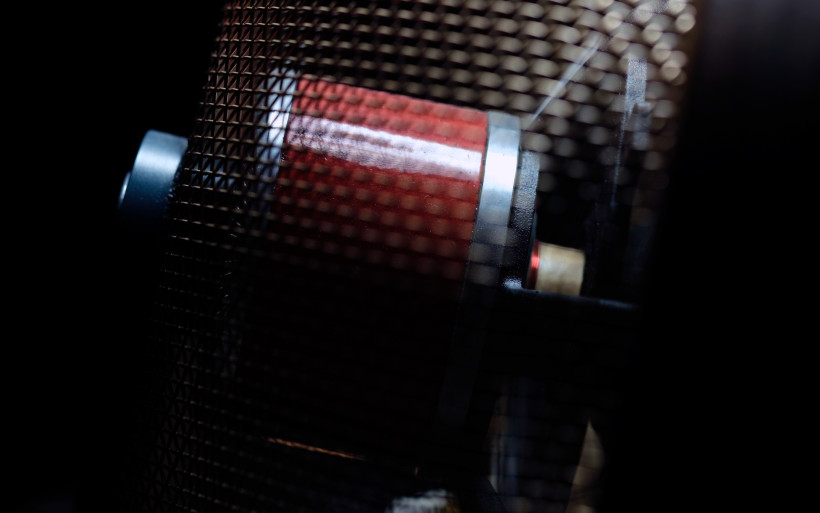 Now let’s fast forward in this timeline to November 2018 and Warsaw’s Audio Video Show. In one of rooms located at the 7th floor of Radisson Blu Sobieski hotel, Martin showcased his latest high performance Vox3 monitors and the well-known Libération, each separately driven by one of the two petite Bakoon AMP-13R lookers positioned on their wooden stands in-between. The goal was to presumably keep both machines ready and willing all time, exclude mood killing cable swaps and have a backup plan in the event of failure. In any case, Martin’s debut in Poland was successful. Many visitors left his room very impressed, whereas to my ears it was among the very best sounding ones of the whole show. On the last day the Swiss kindly loaned me one of his Bakoon amps to play with, the Libération arrived two days later and the game was afoot.
Now let’s fast forward in this timeline to November 2018 and Warsaw’s Audio Video Show. In one of rooms located at the 7th floor of Radisson Blu Sobieski hotel, Martin showcased his latest high performance Vox3 monitors and the well-known Libération, each separately driven by one of the two petite Bakoon AMP-13R lookers positioned on their wooden stands in-between. The goal was to presumably keep both machines ready and willing all time, exclude mood killing cable swaps and have a backup plan in the event of failure. In any case, Martin’s debut in Poland was successful. Many visitors left his room very impressed, whereas to my ears it was among the very best sounding ones of the whole show. On the last day the Swiss kindly loaned me one of his Bakoon amps to play with, the Libération arrived two days later and the game was afoot.
Liberated
Martin’s operation is known among enthusiasts for several reasons. His goods are handmade, costly and built to very high standards, just as any other luxurious Swiss audio affair would. All his products are based on quality components, real wood for acoustic and aesthetic reasons, assembled in Switzerland and far more complex on the inside than their looks might imply. Pleasantly rippled oval Wave 42 or monolithic SK16 are nothing short but cases of artisanal work dressed in appealingly minimalist clothes, whereas this review’s hero indicates clearly that Martin’s focus and goals were elsewhere. When it comes down to out-of-the-box thinking and avoiding mainstream, the man likes to take things to another level and i.e. his soundkaos Wave 40 two-way released years back proves the point very well. It takes quite a degree of audio related knowledge and awareness to fully understand what this product is; where its limitations are and what kind of components/repertoire it respectively needs and fancies to fully flourish and introduce its greatest virtues. If skillfully implemented and married to right hardware, quality full-range transducers are known to do most things admirably well and sound beautifully, but realistically aren’t capable of portraying enormous dynamic contrasts and scale grand orchestral schemes are known for. Different measures have to be involved to get there, in this context inches do matter and – as an enthusiast of such music – Martin knew all too well what had to be done.
When it comes down to out-of-the-box thinking and avoiding mainstream, the man likes to take things to another level and i.e. his soundkaos Wave 40 two-way released years back proves the point very well. It takes quite a degree of audio related knowledge and awareness to fully understand what this product is; where its limitations are and what kind of components/repertoire it respectively needs and fancies to fully flourish and introduce its greatest virtues. If skillfully implemented and married to right hardware, quality full-range transducers are known to do most things admirably well and sound beautifully, but realistically aren’t capable of portraying enormous dynamic contrasts and scale grand orchestral schemes are known for. Different measures have to be involved to get there, in this context inches do matter and – as an enthusiast of such music – Martin knew all too well what had to be done.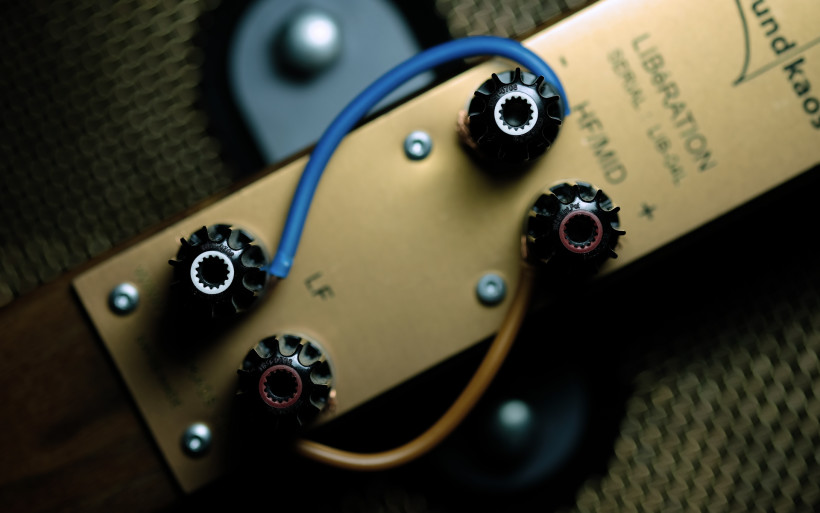 Although Martin’s current lineup doesn’t show, in his pre-soundkaos days there was one open baffle incident, which didn’t make it commercially. But when the crave for orchestral grandeur resurfaced, the enclosure-free agenda was dusted off and one step at a time Libération came to life. It’s also worth to note that two Martin’s long-time collaborators were deeply involved in this project; Christien Ellins of CE Electro-Acoustics and Simon Oehrli of Wagnerei Oehrli. Since the OB topology is inherently liberated from the box, the product’s name itself is quite self-explanatory and very accurate indeed.
Although Martin’s current lineup doesn’t show, in his pre-soundkaos days there was one open baffle incident, which didn’t make it commercially. But when the crave for orchestral grandeur resurfaced, the enclosure-free agenda was dusted off and one step at a time Libération came to life. It’s also worth to note that two Martin’s long-time collaborators were deeply involved in this project; Christien Ellins of CE Electro-Acoustics and Simon Oehrli of Wagnerei Oehrli. Since the OB topology is inherently liberated from the box, the product’s name itself is quite self-explanatory and very accurate indeed.
Build
The product arrived in two separate and large flight cases. Carrying these proved to be the task for two grown ups, whereas unpacking yours truly managed on his own. Each box sported one speaker firmly bolted to its bottom and the extraction process was straightforward. Packaging was clever, secure, made to last and the early impression was utmost positive. One of housings also stored six spring-loaded wooden decoupling feet. In order to be fully operational, each speaker required three mounted; two to its base module and one to a supportive leg located on the rear.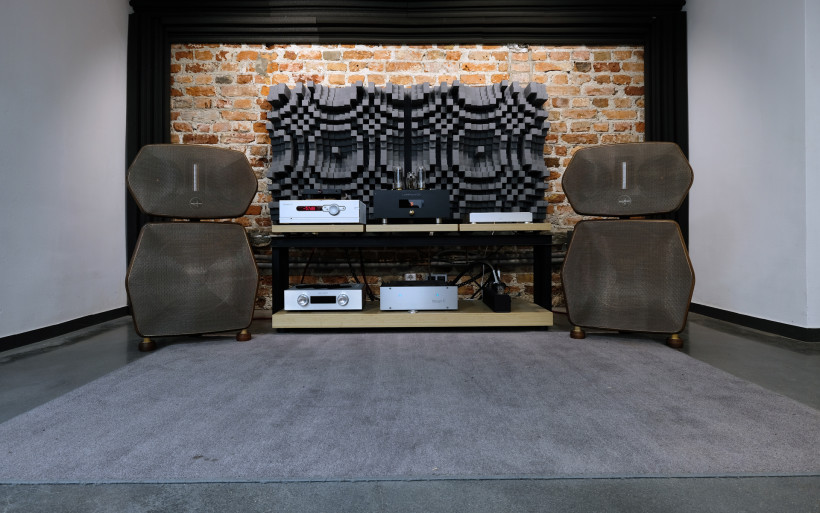 Libération’s nominal impedance is conservatively listed as 4Ω and I was told that it doesn’t drop below 3Ω, whereas this model’s sensitivity is unusually high 96dB (2.83V/RMS). Dimensions of (WxDxH) 60x32x98cm and healthy 42 kilograms of mass per speaker don’t make it a breeze to carry around though manageable, but that’s as far as we’ll go numbers wise. There are far more important things to comment on. The Swiss specimen looks very singular, doesn’t resemble any other product I’ve seen thus far and there were hundreds. Libération’s visuals are in fact the effect of sound profile Martin was after and his mind set on certain components as early as the drawing board stage. It had to be an OB type of product with big sensitive woofers married to full-range drivers and Serbian tweeters he already knew so well.
Libération’s nominal impedance is conservatively listed as 4Ω and I was told that it doesn’t drop below 3Ω, whereas this model’s sensitivity is unusually high 96dB (2.83V/RMS). Dimensions of (WxDxH) 60x32x98cm and healthy 42 kilograms of mass per speaker don’t make it a breeze to carry around though manageable, but that’s as far as we’ll go numbers wise. There are far more important things to comment on. The Swiss specimen looks very singular, doesn’t resemble any other product I’ve seen thus far and there were hundreds. Libération’s visuals are in fact the effect of sound profile Martin was after and his mind set on certain components as early as the drawing board stage. It had to be an OB type of product with big sensitive woofers married to full-range drivers and Serbian tweeters he already knew so well.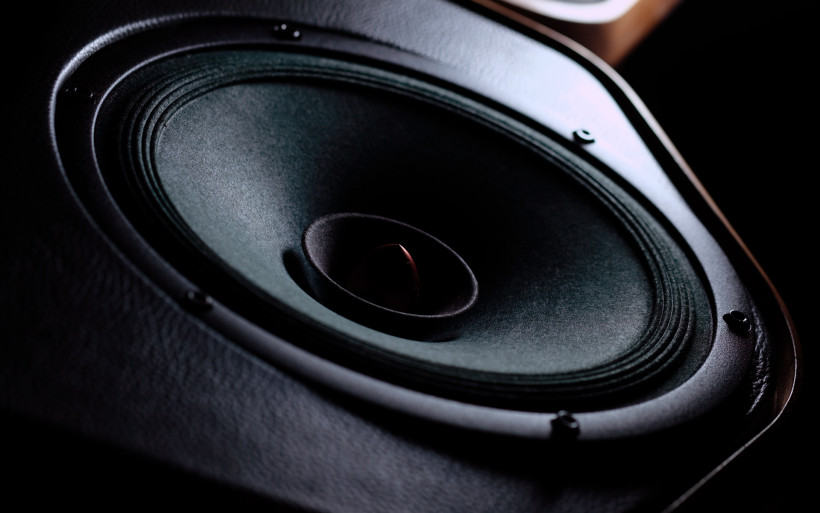 The very first noticeable thing about Libération is the difference between this model and Martin’s previous speakers. Both his Wave 42 and SK16 are based on vented boxes, whereas this report’s main dish is of open baffle full dipole type, thus all of its drivers fire with full force to the front and back. This topology, cones’ diameter and their workload both ways translate to Libération’s massive radiation surface. The OB plan removed from the equation all drawbacks associated with transducers on restrictive duty in typical enclosures, yet introduced new ones. Vented box helps even quite compact woofers in pushing air sufficient enough to have low end properly extended and i.e. my W8’s downstairs department is executed like so, whereas membranes liberated from such assistance generate weaker return strokes, thus have to be far bigger to keep up. In case of Libération it shows, whereas very effortless sound usually associated with big naked bass drivers is what Martin aimed for from the get-go. His choice was Beyma’s 98dB sensitive 18” 18LX60V2 model subject to a 2nd order slope at 200Hz and a simple Zobel phase linearization filter. Transducers this big aren’t common, but it gets even better.
The very first noticeable thing about Libération is the difference between this model and Martin’s previous speakers. Both his Wave 42 and SK16 are based on vented boxes, whereas this report’s main dish is of open baffle full dipole type, thus all of its drivers fire with full force to the front and back. This topology, cones’ diameter and their workload both ways translate to Libération’s massive radiation surface. The OB plan removed from the equation all drawbacks associated with transducers on restrictive duty in typical enclosures, yet introduced new ones. Vented box helps even quite compact woofers in pushing air sufficient enough to have low end properly extended and i.e. my W8’s downstairs department is executed like so, whereas membranes liberated from such assistance generate weaker return strokes, thus have to be far bigger to keep up. In case of Libération it shows, whereas very effortless sound usually associated with big naked bass drivers is what Martin aimed for from the get-go. His choice was Beyma’s 98dB sensitive 18” 18LX60V2 model subject to a 2nd order slope at 200Hz and a simple Zobel phase linearization filter. Transducers this big aren’t common, but it gets even better.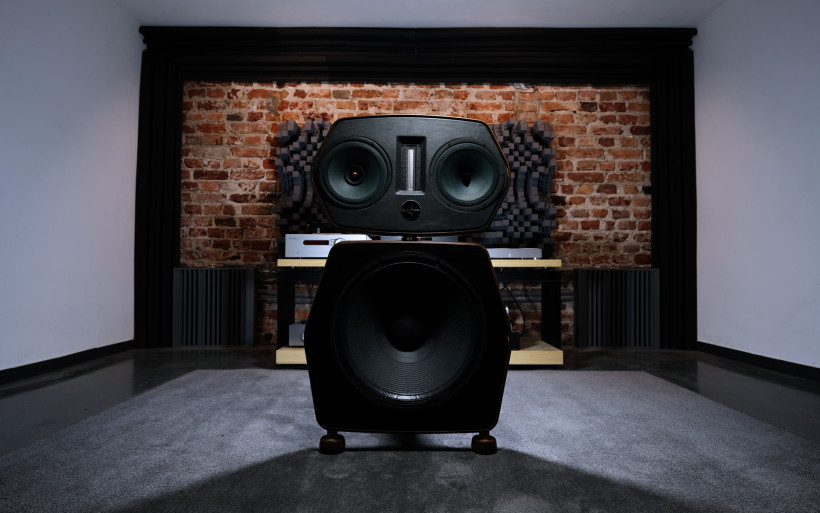 The usual OB case is a vertical array of drivers typically housed by one baffle, but Libération escapes this scheme by exploiting two 36mm thick solid Spruce walls one on top of the other. The 18” monster by Beyma occupies the lower module, whereas horizontal d’Appolito affair is the upper section. More panoramic on imaging count in comparison to the vertical option, it sports three transducers in total; two 8” Enviee widebanders and one Raal ribbon tweeter in-between. Very similar suspects we’ve already seen in previous soundkaos goods. The decision was made to roll with two unfiltered and paralleled Enviee models per channel, but with their spiders and surrounds stiffened plus different phase plugs and motors as well; AlNiCo drives the one loaded with a small whizzer, whereas Neo handles the one without. Notch filters set at 750Hz apply in both cases though and the man behind Enviee transducers – Armin Galm of Galm Audio – performed voice coil adjustments for Martin to keep their impedance in check. At 12kHz Serbian open ribbons take over with 2nd order filter plot and go all the way up to 55kHz. Their transformers are wound with Siltech’s solid silver wire and x-over parts by Duelund, Jantzen and Martin’s own inductors seal the deal.
The usual OB case is a vertical array of drivers typically housed by one baffle, but Libération escapes this scheme by exploiting two 36mm thick solid Spruce walls one on top of the other. The 18” monster by Beyma occupies the lower module, whereas horizontal d’Appolito affair is the upper section. More panoramic on imaging count in comparison to the vertical option, it sports three transducers in total; two 8” Enviee widebanders and one Raal ribbon tweeter in-between. Very similar suspects we’ve already seen in previous soundkaos goods. The decision was made to roll with two unfiltered and paralleled Enviee models per channel, but with their spiders and surrounds stiffened plus different phase plugs and motors as well; AlNiCo drives the one loaded with a small whizzer, whereas Neo handles the one without. Notch filters set at 750Hz apply in both cases though and the man behind Enviee transducers – Armin Galm of Galm Audio – performed voice coil adjustments for Martin to keep their impedance in check. At 12kHz Serbian open ribbons take over with 2nd order filter plot and go all the way up to 55kHz. Their transformers are wound with Siltech’s solid silver wire and x-over parts by Duelund, Jantzen and Martin’s own inductors seal the deal.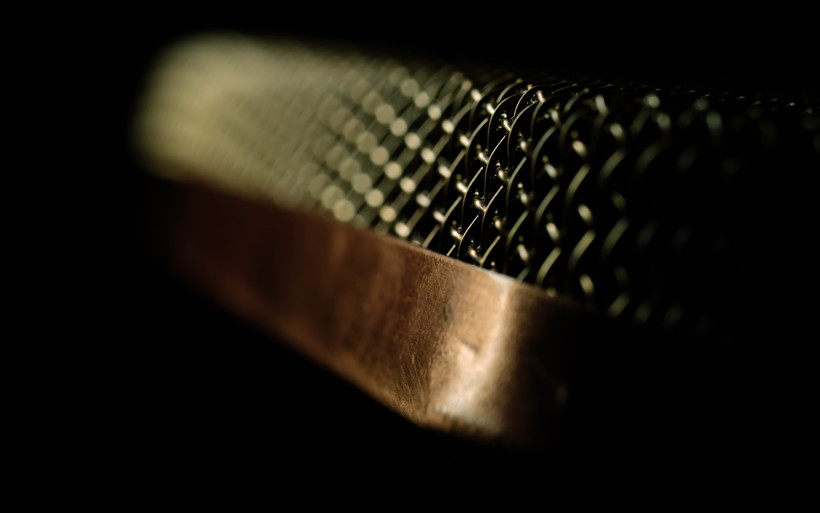 Libération’s visual attractiveness is a matter of one’s personal taste of course. But it’s undeniable that this model is very nicely and thoughtfully put together, whereas the idea of separating its lower baffle from the section above via a short gap and rounding these hexagonal shapes I’ve found brilliant. In his Libération review, Srajan came up with ‘Libby the owl’ name and that’s a spot on description of the Swiss indeed. The birdlike connection is very clear. To move on, the loaner delivered to me had each wall finished with solid Walnut surround and all its covers bronze, though Maple wood and anthracite mesh are available as well. Woven grills on the product’s rear are fixed, whereas their frontal equivalents are easily detachable if needed. The choice is purely cosmetic due to their 70% transparency and lack of any impact on sound quality. Each speaker’s big wooden leg not only connects both baffles via bolts and metal elements, but also serves as a clever hideout for all cables involved, which is very unusual. All similar loudspeakers known to me have their wiring more or less on display, but this wasn’t good enough for Martin and the extra mile he went in this regard I do appreciate. Each leg’s nameplate sports a pair of WBT NextGen speaker terminals, thus bi-amping is allowed. Libération scores very high as far as its materials and components go, whereas its assembly and woodwork are of artisanal level.
Libération’s visual attractiveness is a matter of one’s personal taste of course. But it’s undeniable that this model is very nicely and thoughtfully put together, whereas the idea of separating its lower baffle from the section above via a short gap and rounding these hexagonal shapes I’ve found brilliant. In his Libération review, Srajan came up with ‘Libby the owl’ name and that’s a spot on description of the Swiss indeed. The birdlike connection is very clear. To move on, the loaner delivered to me had each wall finished with solid Walnut surround and all its covers bronze, though Maple wood and anthracite mesh are available as well. Woven grills on the product’s rear are fixed, whereas their frontal equivalents are easily detachable if needed. The choice is purely cosmetic due to their 70% transparency and lack of any impact on sound quality. Each speaker’s big wooden leg not only connects both baffles via bolts and metal elements, but also serves as a clever hideout for all cables involved, which is very unusual. All similar loudspeakers known to me have their wiring more or less on display, but this wasn’t good enough for Martin and the extra mile he went in this regard I do appreciate. Each leg’s nameplate sports a pair of WBT NextGen speaker terminals, thus bi-amping is allowed. Libération scores very high as far as its materials and components go, whereas its assembly and woodwork are of artisanal level.
Sound
In order to review soundkaos Libération, my usual hardware list expanded a bit. The newly arrived fidata HFAS-S10U handled storage and transport duties, then LampizatOr Pacific (KR Audio T-100 + KR Audio 5U4G Ltd. Ed.) took over and fed one of four different machines; Bakoon AMP-13R, Trilogy 925, Kinki Studio EX-M1 and FirstWatt F7 fronted via iFi audio Pro iCAN exploited as a preamplifier.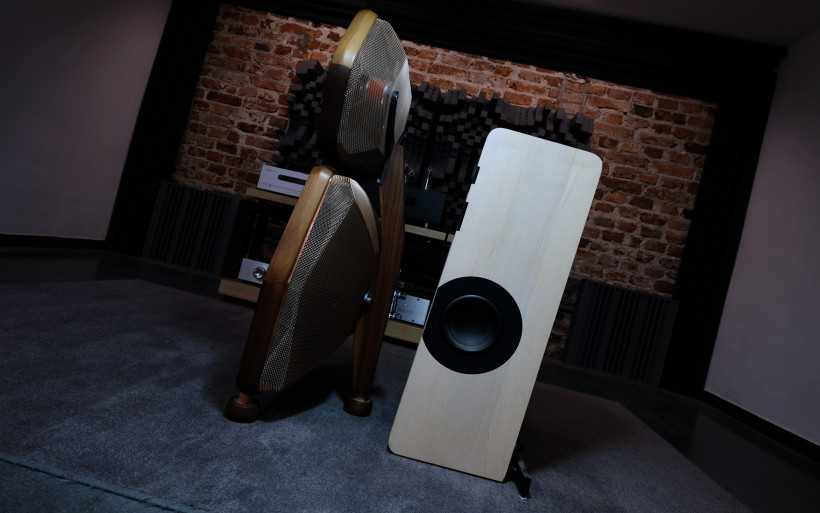 Open baffles are unusual on their own and quite rare, but Martin’s take on this topology upped the singularity ante even more. The product’s placement within my room prior to the key evaluation stage turned out to be far more interesting than it usually is. For instance, numerous tries proved this reporter that his daily driver – Boenicke W8 – favours one specific location over any other at his place and by far. After three years of very extensive usage, choices falsely viewed as viable early on eventually narrowed down to just one. It’s a good thing in this context, simply because this discovery in the past translates to time saved now. Woofers set to fire towards inside, 200/70cm distance to front/side walls respectively, gentle toe in to cross far behind the hot seat, 150cm to each speaker and presto. Once described like so, this specific positioning might look easy-peasy, but it took a while to get there nonetheless.
Open baffles are unusual on their own and quite rare, but Martin’s take on this topology upped the singularity ante even more. The product’s placement within my room prior to the key evaluation stage turned out to be far more interesting than it usually is. For instance, numerous tries proved this reporter that his daily driver – Boenicke W8 – favours one specific location over any other at his place and by far. After three years of very extensive usage, choices falsely viewed as viable early on eventually narrowed down to just one. It’s a good thing in this context, simply because this discovery in the past translates to time saved now. Woofers set to fire towards inside, 200/70cm distance to front/side walls respectively, gentle toe in to cross far behind the hot seat, 150cm to each speaker and presto. Once described like so, this specific positioning might look easy-peasy, but it took a while to get there nonetheless. Libération very quickly introduced more than one feasible placement option to begin with and on this count it clearly was different than my floorstanders. Early on it seemed that this model’s ribbon tweeters by Raal had to be aimed at my noggin precisely and all time, just to discover after several days that this was beneficial in a way yet not necessairly mandatory. Even barely twisted, Martin’s creation was up there with imaging and detailing performance and its widebanders provided some extra wiggle room as well. Their whizzers inside/out audibly influenced soundstage to net result respectively either additionally developed on the sides yet still accurate, or somewhat narrower with space in-between both speakers a notch more emphasized and articulate. The former scenario was my pick, though highly likely this might change in time as both options seemed worth the effort and viable.
Libération very quickly introduced more than one feasible placement option to begin with and on this count it clearly was different than my floorstanders. Early on it seemed that this model’s ribbon tweeters by Raal had to be aimed at my noggin precisely and all time, just to discover after several days that this was beneficial in a way yet not necessairly mandatory. Even barely twisted, Martin’s creation was up there with imaging and detailing performance and its widebanders provided some extra wiggle room as well. Their whizzers inside/out audibly influenced soundstage to net result respectively either additionally developed on the sides yet still accurate, or somewhat narrower with space in-between both speakers a notch more emphasized and articulate. The former scenario was my pick, though highly likely this might change in time as both options seemed worth the effort and viable.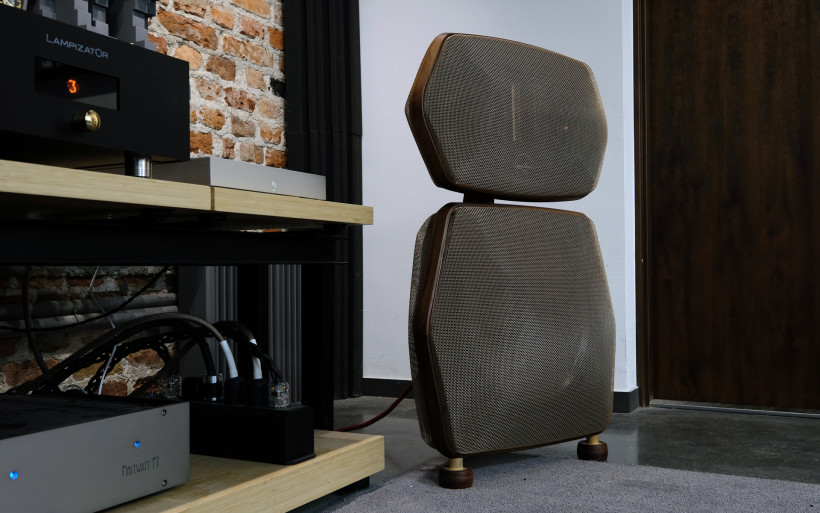 The more distance to front wall was provided, the gutsier and more present low FR was and the ratio of direct vs reflected sound shifted accordingly as well, just as Martin foretold. After the recent Dutch&Dutch 8c experience, the initial plan was to get close and personal with the Libération itself and less with its sound bouncing off surfaces. After several tries at my place any distance within the 100-180cm range to the front wall worked rather well, whereas the ideal sweet spot to this reporter’s ears was 120/70cm to the front/side walls respectively and 3m distance to each speaker. Interestingly, the seat this far within my room is occupied extremely rarely due to placement in-between the realm where standing waves live and severe bass dip right next to it. In most cases it’s simply too tight in there to fit in without suffering the consequences. Reflector Audio Bespoke P15 aside, Libération is the only one which allowed me to use this kosher throne and not be penalized by either of the two well-known drawbacks at the same time. Neither PureAudioProject Trio10 Timeless nor Gradient Revolution or Fikus Electric P-17 got fully away with this murder.
The more distance to front wall was provided, the gutsier and more present low FR was and the ratio of direct vs reflected sound shifted accordingly as well, just as Martin foretold. After the recent Dutch&Dutch 8c experience, the initial plan was to get close and personal with the Libération itself and less with its sound bouncing off surfaces. After several tries at my place any distance within the 100-180cm range to the front wall worked rather well, whereas the ideal sweet spot to this reporter’s ears was 120/70cm to the front/side walls respectively and 3m distance to each speaker. Interestingly, the seat this far within my room is occupied extremely rarely due to placement in-between the realm where standing waves live and severe bass dip right next to it. In most cases it’s simply too tight in there to fit in without suffering the consequences. Reflector Audio Bespoke P15 aside, Libération is the only one which allowed me to use this kosher throne and not be penalized by either of the two well-known drawbacks at the same time. Neither PureAudioProject Trio10 Timeless nor Gradient Revolution or Fikus Electric P-17 got fully away with this murder.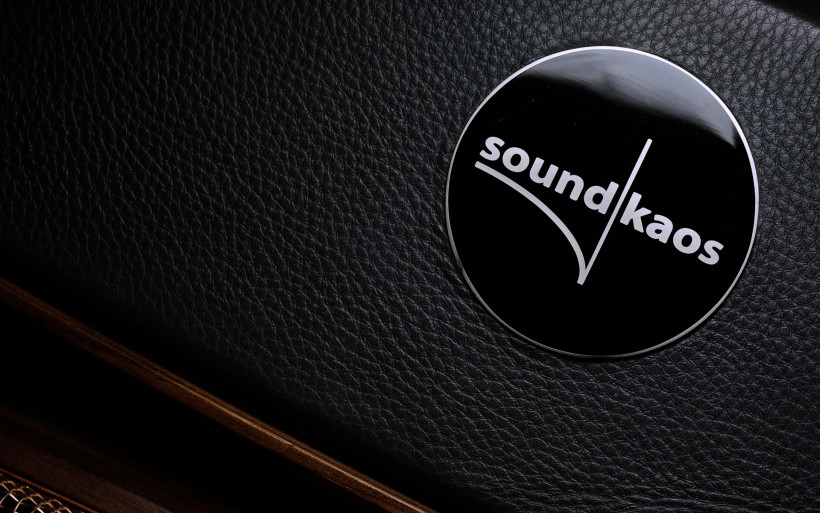 On the surface Libération didn’t look like a mystery. Enormous paper woofers with stiff surrounds indicated snappy and effortless attitude with right companions involved, although texturally possibly a bit pale as well. Air not pressurized within a box vented via a small opening but free instead usually lead to such an outcome. With OBs one usually gets less bloom and heft in favour of more contour, directness, openness and slam. Some things are given, some taken in return and many enthusiasts of such speakers gladly pay the usually fixed price. They simply know what’s at stake. This topology is also known for limited thus beneficial room interaction due to the figure 8 radiation pattern and that was expected of Martin’s product too. Fabulous dipole ribbon tweeters by Raal I’ve already heard in the past too and was prepared for posh and well illuminated upstairs, but a pair of boxless Enviee units right next to each Serbian specimen got me quite puzzled and Libération’s high efficiency additionally spiced things up.
On the surface Libération didn’t look like a mystery. Enormous paper woofers with stiff surrounds indicated snappy and effortless attitude with right companions involved, although texturally possibly a bit pale as well. Air not pressurized within a box vented via a small opening but free instead usually lead to such an outcome. With OBs one usually gets less bloom and heft in favour of more contour, directness, openness and slam. Some things are given, some taken in return and many enthusiasts of such speakers gladly pay the usually fixed price. They simply know what’s at stake. This topology is also known for limited thus beneficial room interaction due to the figure 8 radiation pattern and that was expected of Martin’s product too. Fabulous dipole ribbon tweeters by Raal I’ve already heard in the past too and was prepared for posh and well illuminated upstairs, but a pair of boxless Enviee units right next to each Serbian specimen got me quite puzzled and Libération’s high efficiency additionally spiced things up.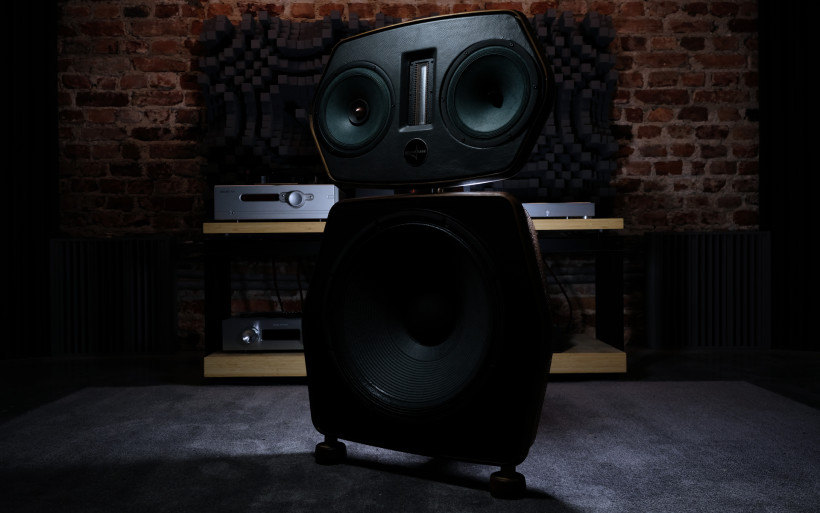 Big cones net big sound for a reason, though sheer size of woofers exploited by this particular topology doesn’t translate to fuzzy, bloated, wobbly and slow bass in most cases and Martin’s product not overloaded on this count isn’t any different. Box not present also rather efficiently removes any boom from equation and unsurprisingly the man’s work ticked off this checkbox as well. Usually such beneficial service doesn’t come for free, trade-offs associated with it do occur. If done right, regular venting introduces fatness and roundness to low FR to make it pleasantly substantial and texturally generous or – as many OB aficionados view it – coloured. That’s why stiffer and drier boxless affairs sound true to this crowd and pale to enthusiasts rollin’ with the usual suspects. The question that begs to be answered now is as follows: where does Libération stand? Is it a typical OB case and that’s that? Or there’s more to it than meets the eye?
Big cones net big sound for a reason, though sheer size of woofers exploited by this particular topology doesn’t translate to fuzzy, bloated, wobbly and slow bass in most cases and Martin’s product not overloaded on this count isn’t any different. Box not present also rather efficiently removes any boom from equation and unsurprisingly the man’s work ticked off this checkbox as well. Usually such beneficial service doesn’t come for free, trade-offs associated with it do occur. If done right, regular venting introduces fatness and roundness to low FR to make it pleasantly substantial and texturally generous or – as many OB aficionados view it – coloured. That’s why stiffer and drier boxless affairs sound true to this crowd and pale to enthusiasts rollin’ with the usual suspects. The question that begs to be answered now is as follows: where does Libération stand? Is it a typical OB case and that’s that? Or there’s more to it than meets the eye? Though the stereotypical talk above proved to be correct to quite an extent, Libération introduced itself as a very surprising product in general and of rather complex nature low FR wise. Its enormous radiation surface and high efficiency led to very agile, exceptionally open and snappy performance typical OB designs are known for. This was very obvious right from the get-go. Huge and utmost quick wall of sound was provided with ease, seemed limitless in scale and the same story was with dynamic contrasts fabulously showcased in music with i.e. cellos or large drums involved. Here stunning Kodo’s “Sado E” and “Shake – Itsuka Mata” or the recently released Apocalyptica’s live take on “Orion” originally by Metallica proved the point very well. Visual grandeur of real instruments presented on these tracks was nothing short of mesmerizing not only due to their finely differentiated size or inherently big on-stage presence, energy and palpability, but also admirable slam, downstairs reach and crack additionally complimented via textural moisture. The takeaway is that Libération brought the usual OB traits to the table and augmented the experience via features in most cases not associated with this topology. It didn’t sound pale at all but very lively instead and that was a fabulous surprise.
Though the stereotypical talk above proved to be correct to quite an extent, Libération introduced itself as a very surprising product in general and of rather complex nature low FR wise. Its enormous radiation surface and high efficiency led to very agile, exceptionally open and snappy performance typical OB designs are known for. This was very obvious right from the get-go. Huge and utmost quick wall of sound was provided with ease, seemed limitless in scale and the same story was with dynamic contrasts fabulously showcased in music with i.e. cellos or large drums involved. Here stunning Kodo’s “Sado E” and “Shake – Itsuka Mata” or the recently released Apocalyptica’s live take on “Orion” originally by Metallica proved the point very well. Visual grandeur of real instruments presented on these tracks was nothing short of mesmerizing not only due to their finely differentiated size or inherently big on-stage presence, energy and palpability, but also admirable slam, downstairs reach and crack additionally complimented via textural moisture. The takeaway is that Libération brought the usual OB traits to the table and augmented the experience via features in most cases not associated with this topology. It didn’t sound pale at all but very lively instead and that was a fabulous surprise.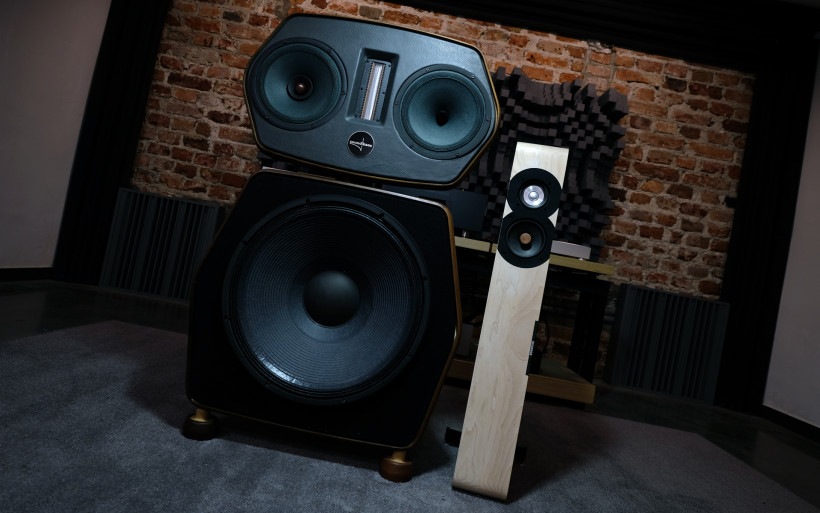 My Boenicke W8 sported more visceral, bloomier and denser character in comparison to Martin’s product, but was also slower, far less elastic and of incomparably smaller posture to be viewed as constricted on sheer scale and effortlessness counts. It’s not about the size of canvas alone, but the ability to paint fully developed vivid images in there and having said this, it became very obvious where the clear differences between Libération and my daily driver were. Inches do matter and a rather short comparison was all it took to get the full message. Even though Boenicke W8 is not cuddly, shy or slow, large taiko drums found in recordings by Kodo, Colin Stetson’s bass saxophone or Rodrigo y Gabriela’s acoustic guitars sounded far livelier and plainly better with Swiss dipoles.
My Boenicke W8 sported more visceral, bloomier and denser character in comparison to Martin’s product, but was also slower, far less elastic and of incomparably smaller posture to be viewed as constricted on sheer scale and effortlessness counts. It’s not about the size of canvas alone, but the ability to paint fully developed vivid images in there and having said this, it became very obvious where the clear differences between Libération and my daily driver were. Inches do matter and a rather short comparison was all it took to get the full message. Even though Boenicke W8 is not cuddly, shy or slow, large taiko drums found in recordings by Kodo, Colin Stetson’s bass saxophone or Rodrigo y Gabriela’s acoustic guitars sounded far livelier and plainly better with Swiss dipoles.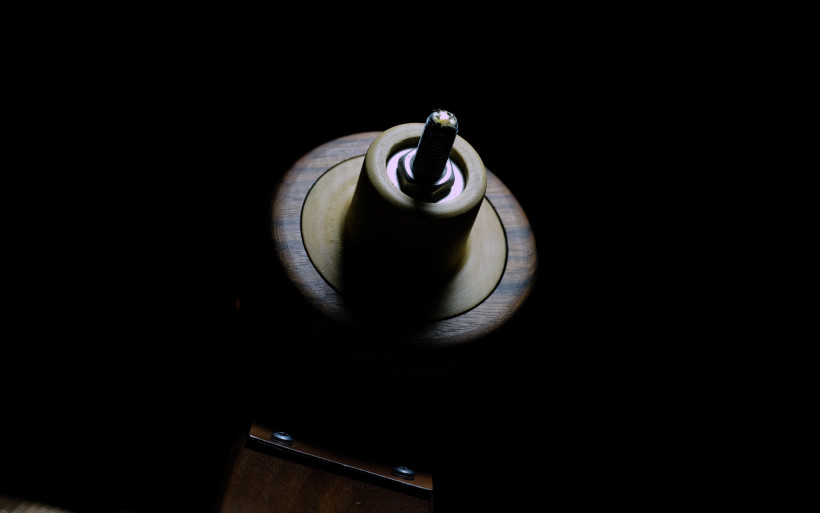 Libération’s Enviee drivers on the job with neighbouring Serbian ribbons handled everything above bass remarkably lively as well. The outcome was finely moisturized, differentiated, posh and not a single thing my very ears found to dislike. In spite of treble anything but shy in amount, not a hint of harshness was present. In fact one of the most surprising and admirable virtues of Libération was its utmost informative overall character and fabulous seasoning. The result was admirably smooth, weighty, exceptionally delicate, airy and it decayed outstandingly on top of that. Of course the product itself proved to be very much recording quality sensitive, it didn’t make music any prettier than it originally was, thus the usual cherry-picking was in order. Nonetheless, time spent on reworking my playlist I consider as not wasted at all.
Libération’s Enviee drivers on the job with neighbouring Serbian ribbons handled everything above bass remarkably lively as well. The outcome was finely moisturized, differentiated, posh and not a single thing my very ears found to dislike. In spite of treble anything but shy in amount, not a hint of harshness was present. In fact one of the most surprising and admirable virtues of Libération was its utmost informative overall character and fabulous seasoning. The result was admirably smooth, weighty, exceptionally delicate, airy and it decayed outstandingly on top of that. Of course the product itself proved to be very much recording quality sensitive, it didn’t make music any prettier than it originally was, thus the usual cherry-picking was in order. Nonetheless, time spent on reworking my playlist I consider as not wasted at all.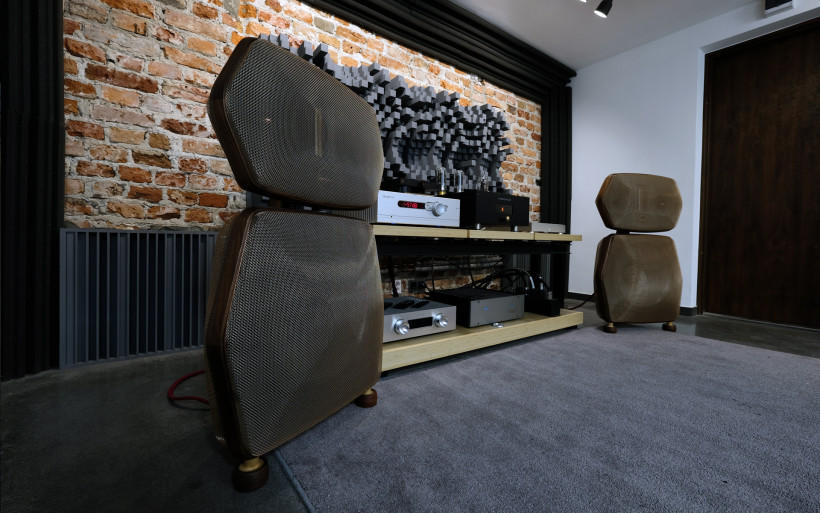 Open baffles known to this reporter didn’t perform the vanishing act as potently as his W8. That’s why the early assumption of rather large Libération not particularly fit to excel at this task seemed rather reasonable, whereas in practice the exact opposite thing happened. Martin’s product proved to be utmost capable in this regard. It disappeared as completely and effortlessly as my W8 to be eventually mapped as one of the very best ones on this count I’ve heard at my place thus far. Soundstage wise Libération was nothing short of grand; it sang very openly, tangibly and limitlessly to be viewed as an organism equipped with a pair of very capable fully developed set of lungs. It focused my attention not on pinpoint accuracy but big and uniform sound sources served in coherent and direct fashion. Boenicke W8 took me to its place whereas Martin’s product materialized instruments at mine and these approaches weren’t alike at all. The difference wasn’t in sheer width, height or depth but two radically distinct takes on how to fill this huge space. Libération clearly favoured grandeur, boldness and directness to provide lifelike sensation of music being here, whereas the more romantic W8 sketched smaller and more distant shapes. Nonetheless, with i.e. live and acoustic repertoire the costlier Swiss did substantially better job.
Open baffles known to this reporter didn’t perform the vanishing act as potently as his W8. That’s why the early assumption of rather large Libération not particularly fit to excel at this task seemed rather reasonable, whereas in practice the exact opposite thing happened. Martin’s product proved to be utmost capable in this regard. It disappeared as completely and effortlessly as my W8 to be eventually mapped as one of the very best ones on this count I’ve heard at my place thus far. Soundstage wise Libération was nothing short of grand; it sang very openly, tangibly and limitlessly to be viewed as an organism equipped with a pair of very capable fully developed set of lungs. It focused my attention not on pinpoint accuracy but big and uniform sound sources served in coherent and direct fashion. Boenicke W8 took me to its place whereas Martin’s product materialized instruments at mine and these approaches weren’t alike at all. The difference wasn’t in sheer width, height or depth but two radically distinct takes on how to fill this huge space. Libération clearly favoured grandeur, boldness and directness to provide lifelike sensation of music being here, whereas the more romantic W8 sketched smaller and more distant shapes. Nonetheless, with i.e. live and acoustic repertoire the costlier Swiss did substantially better job.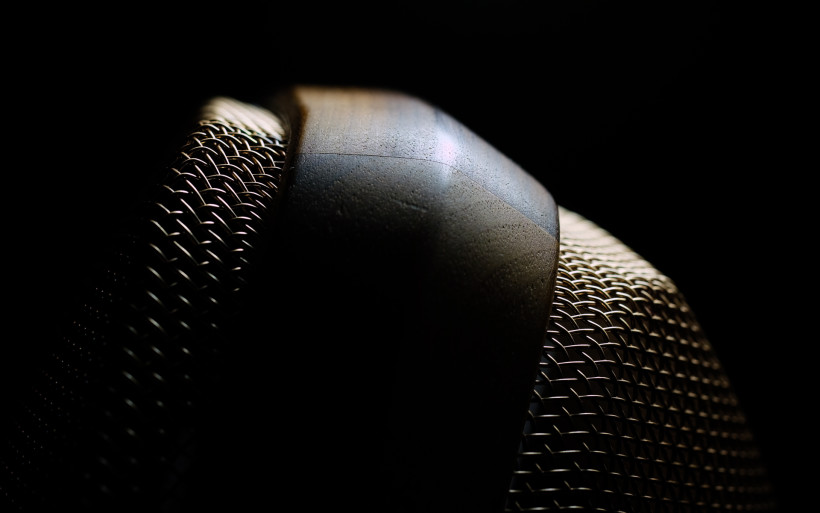 By completely vanishing from my room and merging OB alike bass characteristic with textural richness, Libération efficiently broke several stereotypes associated with its breed. The well-known bell rang loud and clear. Łukasz Fikus with his Fikus Electric P-17 was after the same thing; a full dipole affair of high efficiency, additionally loaded with stiff and large woofers augmented by Raal ribbons and paper midrange transducers. In spite of many undeniable similarities and goals, the difference between Polish and Swiss work is very clear as well. The former is huge, backed by big clunky rear and – due to unusually high midrange drivers placement – it lifts soundstage to make it a bit unnatural if one sits too close. In order to counteract this I’d have to have a far bigger room. Martin’s product pulled off everything the P-17 did, in many ways bested it, didn’t require space larger than the one provided and arrived dressed in far sharper and domesticated suit on top of that. In this context it’s fully known where all the extra money went. This confession is based on one person’s memory, though. If far bigger room would’ve been involved then who knows, perhaps the gap between the two would be smaller, I can’t say.
By completely vanishing from my room and merging OB alike bass characteristic with textural richness, Libération efficiently broke several stereotypes associated with its breed. The well-known bell rang loud and clear. Łukasz Fikus with his Fikus Electric P-17 was after the same thing; a full dipole affair of high efficiency, additionally loaded with stiff and large woofers augmented by Raal ribbons and paper midrange transducers. In spite of many undeniable similarities and goals, the difference between Polish and Swiss work is very clear as well. The former is huge, backed by big clunky rear and – due to unusually high midrange drivers placement – it lifts soundstage to make it a bit unnatural if one sits too close. In order to counteract this I’d have to have a far bigger room. Martin’s product pulled off everything the P-17 did, in many ways bested it, didn’t require space larger than the one provided and arrived dressed in far sharper and domesticated suit on top of that. In this context it’s fully known where all the extra money went. This confession is based on one person’s memory, though. If far bigger room would’ve been involved then who knows, perhaps the gap between the two would be smaller, I can’t say.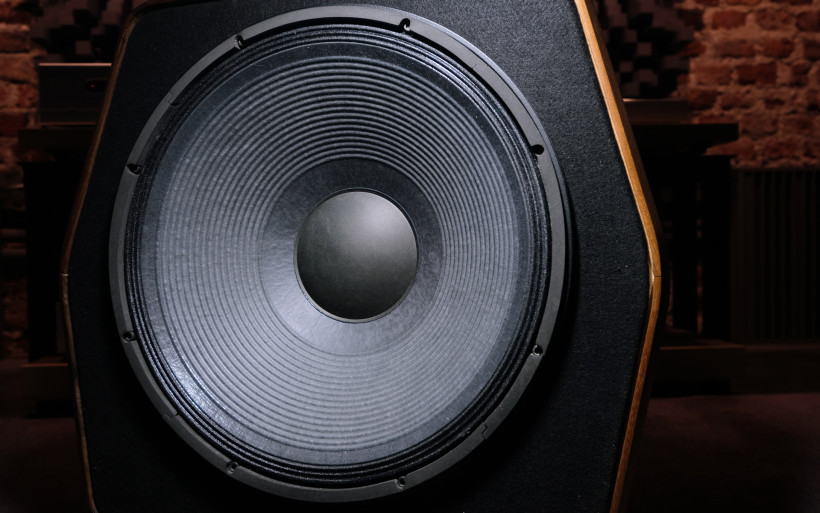 Libération’s unusually high efficiency significantly expanded the list of suitable hardware. Low power decks seemed more than valid with this product and Martin proved the point rather well during this year’s local Audio Video Show. Back then his open baffles sang with Bakoon AMP-13R. Based on Exicon’s lateral Mosfets and said company’s proprietary Satri circuit, this petite integrated machine of merely 4 kilograms mass and 25wpc into 8Ω load did outstandingly well, which is the reason why it arrived along with Mr Gateley’s speakers. A product this big married to an amp this small might look odd to say the least, but fully developed and posh outcome heard at the AVS event clearly indicated high tiered synergy.
Libération’s unusually high efficiency significantly expanded the list of suitable hardware. Low power decks seemed more than valid with this product and Martin proved the point rather well during this year’s local Audio Video Show. Back then his open baffles sang with Bakoon AMP-13R. Based on Exicon’s lateral Mosfets and said company’s proprietary Satri circuit, this petite integrated machine of merely 4 kilograms mass and 25wpc into 8Ω load did outstandingly well, which is the reason why it arrived along with Mr Gateley’s speakers. A product this big married to an amp this small might look odd to say the least, but fully developed and posh outcome heard at the AVS event clearly indicated high tiered synergy.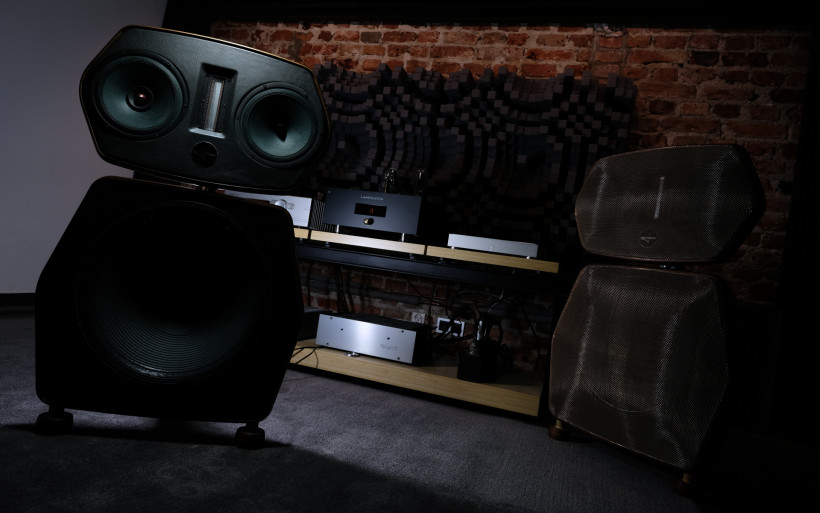 Libération’s sound profile described above is the result of its marriage to Bakoon’s little thing. The time to separate this couple eventually has come, additional tools followed and Trilogy 925 was first in line. On the job with Martin’s product it significantly changed the outcome. Sound got denser, bloomier, darker, less open yet respectable still. Contour decreased a bit as well and, along with stronger focus on events in-between both speakers, it invoked somewhat dreamy and softer qualities very much desirable with i.e. Julee Cruise’s “Floating” and “Goodbye Horses” by Q Lazzarus. Additional pigment the 925 injected also served this type of music well, though masked what Libération was truly capable of in the long run, its on-stage grandeur and openness shrunk a notch. The only thing I’d like to have at times a bit elevated with Bakoon’s amp was additional bass heft introduced by the Brit, even though it led to somewhat limited attack and lesser directness OB designs do so well.
Libération’s sound profile described above is the result of its marriage to Bakoon’s little thing. The time to separate this couple eventually has come, additional tools followed and Trilogy 925 was first in line. On the job with Martin’s product it significantly changed the outcome. Sound got denser, bloomier, darker, less open yet respectable still. Contour decreased a bit as well and, along with stronger focus on events in-between both speakers, it invoked somewhat dreamy and softer qualities very much desirable with i.e. Julee Cruise’s “Floating” and “Goodbye Horses” by Q Lazzarus. Additional pigment the 925 injected also served this type of music well, though masked what Libération was truly capable of in the long run, its on-stage grandeur and openness shrunk a notch. The only thing I’d like to have at times a bit elevated with Bakoon’s amp was additional bass heft introduced by the Brit, even though it led to somewhat limited attack and lesser directness OB designs do so well. Kinki Studio EX-M1 next in line I’ve found similarly voiced to the AMP 13-R. These two machines vary in price, size and output power, but their core characteristic is quite alike. The major difference was in usable volume range of course, but details related directly to sound also were audible enough to be rather quickly viewed as important. Bakoon’s machine not only was more than sufficient to drive Libération, but it also had an edge over the EX-M1 on counts such as smoothness, resolution and ability to paint more delicate and vivid images. The former simply played in the upper league, but the contest between these two I’ll tackle in the upcoming publication devoted to the AMP 13-R exclusively as it surely deserves one.
Kinki Studio EX-M1 next in line I’ve found similarly voiced to the AMP 13-R. These two machines vary in price, size and output power, but their core characteristic is quite alike. The major difference was in usable volume range of course, but details related directly to sound also were audible enough to be rather quickly viewed as important. Bakoon’s machine not only was more than sufficient to drive Libération, but it also had an edge over the EX-M1 on counts such as smoothness, resolution and ability to paint more delicate and vivid images. The former simply played in the upper league, but the contest between these two I’ll tackle in the upcoming publication devoted to the AMP 13-R exclusively as it surely deserves one.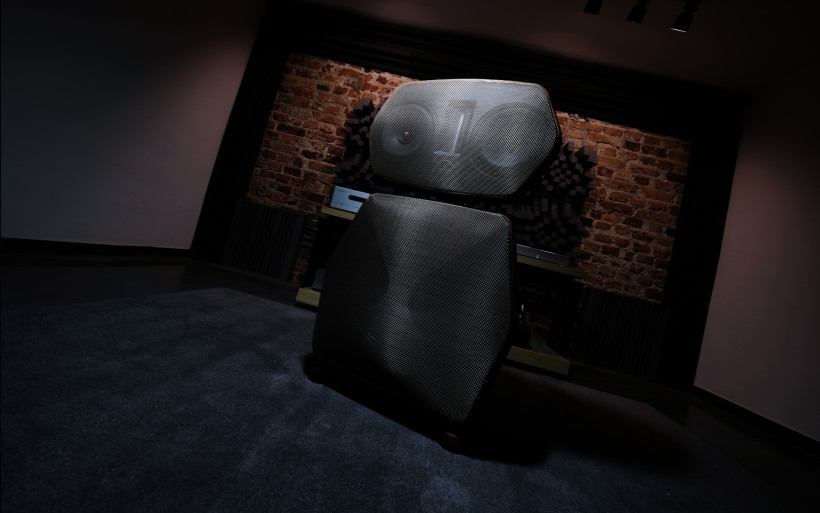 iFi audio iCAN and FirstWatt F7 was the last stop. Although perfectly enjoyable, this duo was the fuzziest, the warmest and the most stingy on details of all hardware combinations involved. If we’ll now assume that Kinki Studio EX-M1 occupies the most contoured, quick, open and dry end of the whole spectrum, then Nelson’s power amp along with iFi’s machine sit at the opposite one. Trilogy 925 is found quite closely to the latter and Bakoon AMP-13R located somewhere in-between this product and Kinki Studio’s integrated turned out to be the most balanced option of them all. After all triangulations conducted I can only say that one of the smallest and the prettiest integrated machines known to me – the AMP 13-R – proved to be a spot on choice for Libération indeed.
iFi audio iCAN and FirstWatt F7 was the last stop. Although perfectly enjoyable, this duo was the fuzziest, the warmest and the most stingy on details of all hardware combinations involved. If we’ll now assume that Kinki Studio EX-M1 occupies the most contoured, quick, open and dry end of the whole spectrum, then Nelson’s power amp along with iFi’s machine sit at the opposite one. Trilogy 925 is found quite closely to the latter and Bakoon AMP-13R located somewhere in-between this product and Kinki Studio’s integrated turned out to be the most balanced option of them all. After all triangulations conducted I can only say that one of the smallest and the prettiest integrated machines known to me – the AMP 13-R – proved to be a spot on choice for Libération indeed.
Summary
At first glance, soundkaos Libération gives a way to think that its creator clearly doesn’t keep up with trends. Lack of box turns big woofers into a necessity, wide frame which follows in the process is visually neither sleek nor safe or modern and this review’s hero isn’t any different on this count. But to remain outside of the mainstream realm, just as most OB cases do, is no crime at all. On the contrary, said topology oftentimes nets spectacular results and Libération proved the point very well, mainstream looks be damned. Martin Gateley not only thinks outside the box, but also doesn’t have to play the eye candy game. With such a performer in his portfolio, why would he?
Open baffles easy to pull off is the common misconception shared by many individuals not familiar with such goods, whereas in reality these can take as much time as any regular speaker would or even more. Thorough inspection of the Swiss loaner left no room for guesswork, it took a lot of effort and resources. Overall attention to details, respectable rigidity, bronze grills shaped to perfectly fit their slots and not a single cable anywhere in sight all indicate how much thought went into this cleverly designed luxurious item. Even though not every décor sensitive lady of the house will embrace this Swiss view, its visual aesthetic my subjective pair of eyes has found brilliant and appealing.
Along with Libération’s intriguing appearance came its unusual sound characteristic. Due to effortless, open, direct, very much uncompressed and boom free attitude, it clearly fits the typical OB profile. But additionally augmented via several highly beneficial twists usually off limits to such speakers, the Swiss caught me off guard. It sported downstairs not pale or/and dry but pleasantly moisturized, massive and utmost agile, everything above it served admirably seasoned and fresh, filled my place with spectacularly big multi-layered wall of engaging sound and vanished from this space completely on top of that. No other OB specimen I’m familiar with delivered all this and was of similarly domestic size. Put shortly, in time Libération morphed into one of the most enjoyable and the very best speakers to my ears. As an example of fabulously voiced Swiss audio engineering and a work of art made by a true passionate, it will be dearly missed. Bravo and ‘till next time!
Associated equipment:
- Amplifiers: Bakoon AMP-13R, Kinki Audio EX-M1, Trilogy 925, FirstWatt F7
- Sources: LampizatOr Pacific (KR Audio T-100 + KR Audio 5U4G Ltd. Ed.)
- Speakers: Boenicke Audio W8
- Preamplifiers: iFi audio Pro iCAN
- Transports: Asus UX305LA
- Speaker cables: Forza AudioWorks Noir Concept, Audiomica Laboratory Celes Excellence
- Interconnects: Audiomica Laboratory Erys Excellence
- Power components: Gigawatt PF-2 + Gigawatt LC-2 MK2 + Forza AudioWorks Noir Concept/Audiomica Laboratory Ness Excellence/LessLoss C-MARC
- Rack: Franc Audio Accesories Wood Block Rack
- Music: NativeDSD
Retail prices of reviewed components in EU (excl. VAT):
- soundkaos Libération: €17‘500
Manufacturer: soundkaos



































